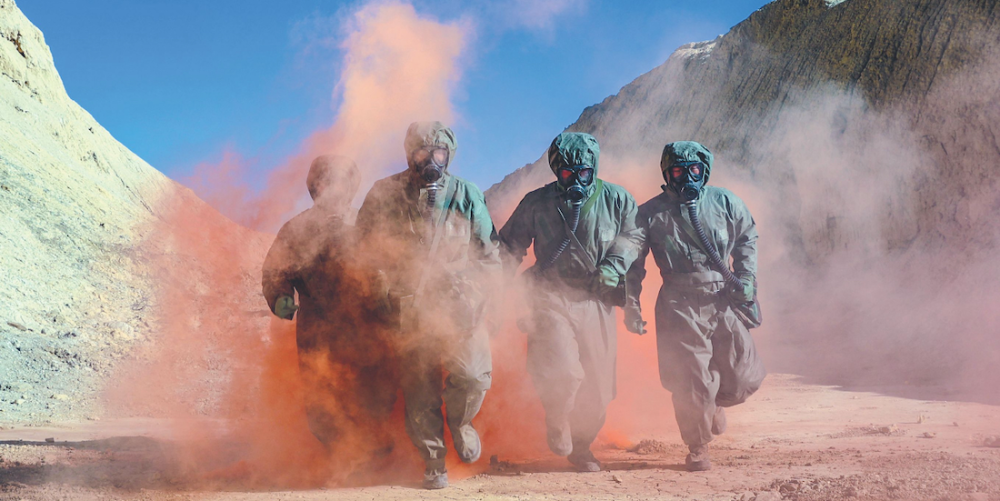
Beijing’s Strategic Investment in Chemical Defense Units Signals Enhanced Military Preparedness and Regional Security Implications
New York, N.Y. — The People’s Liberation Army‘s evolving brigade structure has undergone significant transformation in recent years, with chemical defense companies emerging as critical components of China‘s military modernization strategy. These specialized units, integrated within combined arms brigades across the PLA Ground Force, represent a sophisticated approach to contemporary warfare challenges and reflect Beijing‘s commitment to comprehensive military capability enhancement.
Enhanced Brigade Structure Integration
The PLA heavy, medium, and light combined arms brigades share a modular construct, resembling its superior and subordinate units at the corps and battalion level. A typical PLAGF combined arms brigade has the brigade HQ, four maneuver combat battalions, and other support battalions. Within this framework, chemical defense companies serve as force multipliers, providing essential chemical, biological, radiological, and nuclear (CBRN) protection capabilities that ensure operational continuity in contaminated environments.
The integration of chemical companies within brigade structures represents a departure from traditional military organization. Rather than maintaining separate chemical units at higher echelons, the PLA has embedded these capabilities at the brigade level, enabling rapid response to chemical threats and enhanced survivability for ground forces. This organizational philosophy reflects lessons learned from contemporary conflicts where chemical weapons have emerged as significant tactical considerations.

Technological Advancement and Equipment Modernization
Chinese military chemical companies have benefited from substantial investments in advanced detection and protection equipment. Modern chemical detection systems deployed by these units incorporate sophisticated sensor arrays capable of identifying various chemical agents in real-time. The technology enables rapid contamination assessment and facilitates informed decision-making during operations.
Personal protective equipment used by PLA chemical defense personnel has evolved significantly, incorporating lightweight materials and improved filtration systems. These advances allow soldiers to maintain operational effectiveness while protected from chemical threats, addressing historical challenges where protective equipment severely limited mobility and endurance.
Training and Operational Readiness

The PLA has implemented comprehensive training programs for chemical defense companies, emphasizing both technical proficiency and tactical integration.
Personnel undergo extensive instruction in chemical agent identification, decontamination procedures, and protective equipment operation.
Additionally, these units participate in joint exercises with other brigade elements, ensuring seamless coordination during combined operations.
Recent military exercises have demonstrated the effectiveness of these training programs.
Chemical defense companies have successfully conducted decontamination operations while maintaining operational tempo, showcasing their ability to support sustained combat operations in contaminated environments.
These capabilities prove particularly valuable in urban warfare scenarios where chemical threats may be prevalent.
Strategic Implications and Regional Security
The emphasis on chemical defense capabilities within PLA brigades carries significant implications for regional security dynamics. Neighboring countries have observed China’s chemical defense modernization with interest, recognizing the enhanced survivability and operational flexibility these capabilities provide. The presence of well-equipped chemical defense units may influence adversary calculations regarding the use of chemical weapons in potential conflicts.
Furthermore, these capabilities extend beyond traditional military applications. Chemical defense companies possess dual-use capabilities that could prove valuable in responding to industrial accidents, natural disasters, or terrorist incidents involving chemical agents. This versatility enhances China’s overall national security posture while providing humanitarian response capabilities.
Future Development Trajectories
The continued evolution of PLA chemical defense companies appears likely as military leaders recognize their growing importance in modern warfare. Future developments may include enhanced autonomous detection systems, improved protective equipment, and expanded decontamination capabilities. The integration of artificial intelligence and machine learning technologies could further enhance these units’ effectiveness in identifying and responding to chemical threats.
International observers note that China’s investment in chemical defense capabilities reflects broader trends in military modernization. As potential adversaries develop chemical weapons capabilities, the PLA’s emphasis on protection and response becomes increasingly relevant. The brigade-level integration of these capabilities ensures that chemical defense remains a priority consideration in military planning and operations.
The strategic significance of chemical defense companies within PLA brigades extends beyond immediate military applications, representing a comprehensive approach to national security challenges in an increasingly complex global environment.
Summary for Audio File
Chinese military chemical defense companies have become integral components of People’s Liberation Army brigade structures, providing enhanced protection against chemical, biological, radiological, and nuclear threats. These specialized units feature advanced detection equipment, comprehensive training programs, and dual-use capabilities extending beyond traditional military applications. The integration reflects China’s broader military modernization strategy and carries significant implications for regional security dynamics.